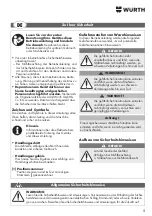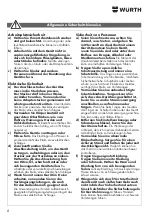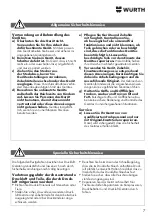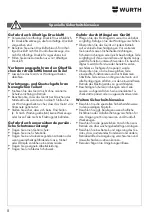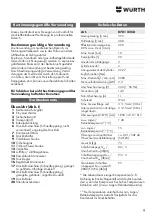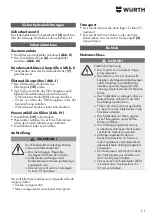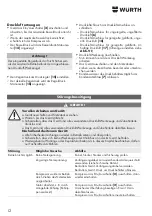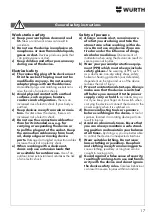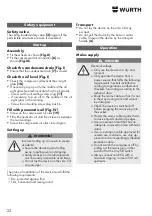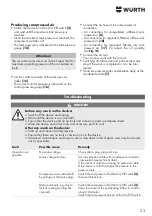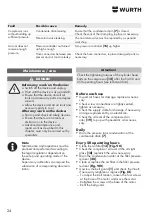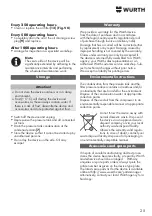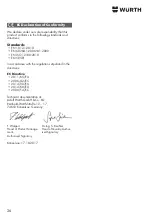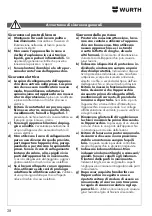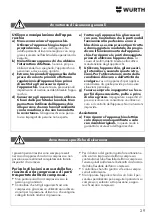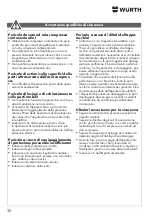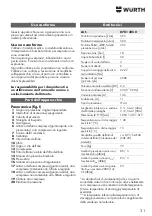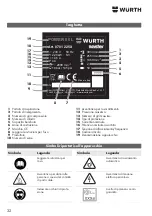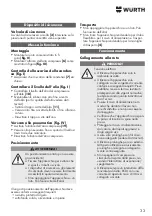
18
General safety instructions
Use and treatment of the device
a) Do not overload the device. Use the
correct device for your work.
Use of the
appropriate device for the specified power
range means you can work better with opti-
mised safety.
b) Never use a device if it has a defective
switch.
If a device cannot be switched on
or off, it must be repaired because further use
would be dangerous.
c) Before adjusting the device settings
or changing accessories, always pull
the power plug out of the socket to
prevent inadvertent start-up of the
device.
This precautionary measure prevents
the unintentional starting of the device.
d) Keep unused devices out of the reach
of children. Never allow persons who
are unfamiliar with this type of device
to use it, nor anyone who has not read
these instructions.
Devices are dangerous if
used by inexperienced persons.
e) Maintain devices and accessories with
care. Check that moving parts are
working correctly and do not jam, and
that parts are not broken or damaged
such that device operation would be
impaired. Damaged parts must be
repaired before the device is used.
Many accidents result from poorly maintained
devices.
f) Use device, accessories, accessory
tools and so on in accordance with
these instructions. In doing so, take
into account the conditions of work
and the activity to be performed.
The
use of devices for applications other than those
intended can result in hazardous situations.
g) Keep the handles and gripping sur-
faces dry, clean and free from oil and
grease.
Slippery handles and gripping surfac-
es prevent safe operation and impede control
of the device in unforeseen situations.
Service
a) All repairs to the device must be car-
ried out by qualified specialist tech
-
nicians and with original spare parts
only.
This will ensure the continuing safe
operation of the device.
Special safety instructions
The following residual hazards are always present
with compressed air devices and cannot be com-
pletely eliminated by safety devices:
Risk of injury due to escaping com-
pressed air and parts which may be
swept up with the compressed air!
▸
Never direct the compressed air directly at
people or animals.
▸
Ensure that all compressed air devices and acces
-
sory parts used are designed for the working
pressure or are connected via pressure reducers.
▸
When undoing the quick-release coupling, be
aware that the compressed air contained in the
air hose may suddenly escape. Therefore hold
the end of the air hose that is being released
firmly.
▸
Ensure that all screw connections are always fully
tightened.
▸
Do not repair the device yourself. Only special-
ists may repair compressors, pressure tanks and
compressed air devices.
Summary of Contents for 0701 225 0
Page 3: ...3 I 6 14 5 4 3 2 13 11 10 9 12 8 7 1 15 16 17 18 19 20...
Page 4: ...4 II III IV V VI VII VIII IX 6 19 13 1...
Page 126: ...126 GR Adolf W rth GmbH Co KG 3 1...
Page 127: ...127 a b c a b c d e a b c d e f g...
Page 128: ...128 a b c d e f g a...
Page 129: ...129...
Page 132: ...132 3 II 6 III I 7 I 10 11 IV 19 4 RCD 30 mA 2 3 3 14...
Page 133: ...133 15 3 16 6 18 17 VI 3 7 2 2 10...
Page 134: ...134 7 15 50 250 12 19 7 50 13 VII 10 20 VIII 1 IX...
Page 214: ...214 BG Adolf W rth GmbH Co KG 3 1...
Page 215: ...215 a b c a b c d e a b c d e f g...
Page 216: ...216 a b c d e f g a...
Page 217: ...217...
Page 220: ...220 3 II 6 III I 7 I 10 11 IV 19 4 RCD 30 mA...
Page 221: ...221 2 3 3 14 15 3 16 6 18 17 VI 3 7 2 2 10...
Page 222: ...222 7 15 50 250 12 19 7 50 13 VII 10 20 VIII 1 IX...
Page 258: ...258 RU Adolf W rth GmbH Co KG 3 1...
Page 259: ...259 a b c a b c d e a b c d e f g...
Page 260: ...260 a b c d e f g a...
Page 261: ...261...
Page 264: ...264 3 II 6 III I 7 I 10 11 IV 19 4 RCD 30...
Page 265: ...265 2 3 3 14 15 3 16 6 18 17 VI 3 7 2 2 10...
Page 266: ...266 7 15 50 250 12 19 7 50 13 VII 10 20 VIII 1 IX...
Page 291: ......


